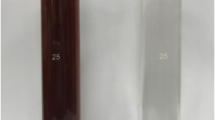Abstract
The decomposition of copper anode slime heated by microwave energy in a sulfuric acid medium was investigated. Leaching experiments were carried out in a multi-mode cavity with microwave assistance. The leaching process parameters were optimized using response surface methodology (RSM). Under the optimized conditions, the leaching efficiencies of copper and tellurium were 99.56% ± 0.16% and 98.68% ± 0.12%, respectively. Meanwhile, a conventional leaching experiment was performed in order to evaluate the influence of microwave radiation. The mechanism of microwave-assisted leaching of copper anode slime was also investigated. In the results, the microwave technology is demonstrated to have a great potential to improve the leaching efficiency and reduce the leaching time. The enhanced recoveries of copper and tellurium are believed to result from the presence of a temperature gradient due to the shallow microwave penetration depth and the superheating at the solid-liquid interface.
Similar content being viewed by others
References
W.F. Liu, T.Z. Yang, D.C. Zhang, L. Chen, and Y.N. Liu, Pretreatment of copper anode slime with alkaline pressure oxidative leaching, Int. J. Miner. Process., 128(2014), p. 48.
Y. Kilic, G. Kartal, and S. Timur, An investigation of copper and selenium recovery from copper anode slimes, Int. J. Miner. Process., 124(2013), p. 75.
J.H. Huang and N.A. Rowson, Hydrometallurgical decomposition of pyrite and marcasite in a microwave field, Hydrometallurgy, 64(2002), No. 3, p. 169.
Y. Hua, Z. Lin, and Z. Yan, Application of microwave irradiation to quick leach of zinc silicate ore, Miner. Eng., 15(2002), No. 6, p. 451.
D. Jafarifar, M.R. Daryanavard, and S. Sheibani, Ultra fast microwave-assisted leaching for recovery of platinum from spent catalyst, Hydrometallurgy, 78(2005), No. 3-4, p. 166.
P.A. Olubambi, J.H. Potgieter, J.Y. Hwang, and S. Ndlovu, Influence of microwave heating on the processing and dissolution behaviour of low-grade complex sulphide ores, Hydrometallurgy, 89(2007), No. 1-2, p. 127.
X.J. Zhai, Y. Fu, X. Zhang, L.Z. Ma, and F. Xie, Intensification of sulphation and pressure acid leaching of nickel laterite by microwave radiation, Hydrometallurgy, 99(2009), No. 3-4, p. 189.
I.S.S. Pinto and H.M.V.M. Soares, Selective leaching of molybdenum from spent hydrodesulphurisation catalysts using ultrasound and microwave methods, Hydrometallurgy, 129-130(2012), p. 19.
S.U. Bayca, Microwave radiation leaching of colemanite in sulfuric acid solutions, Sep. Purif. Technol., 105(2013), p. 24.
I.S.S. Pinto and H.M.V.M. Soares, Microwave-assisted selective leaching of nickel from spent hydrodesulphurization catalyst: A comparative study between sulphuric and organic acids, Hydrometallurgy, 140(2013), p. 20.
M. Al-Harahsheh and S.W. Kingman, Microwave-assisted leaching: a review, Hydrometallurgy, 73(2004), No. 3-4, p. 189.
M. Al-Harahsheh, S. Kingman, and S. Bradshaw, The reality of non-thermal effects in microwave assisted leaching systems, Hydrometallurgy, 84(2006), No. 1-2, p. 1.
M. Al-Harahsheh, S. Kingman, N. Hankins, C. Somerfield, S. Bradshaw, and W. Louw, The influence of microwaves on the leaching kinetics of chalcopyrite, Miner. Eng., 18(2005), No. 13-14, p. 1259.
M. Al-Harahsheh and S. Kingman, The influence of microwaves on the leaching of sphalerite in ferric chloride, Chem. Eng. Process., 47(2008), No. 8, p. 1246.
A.J. Makadia and J.I. Nanavati, Optimisation of machining parameters for turning operations based on response surface methodology, Measurement, 46(2013), No. 4, p. 1521.
X.L. Yin, Q.H. You, and Z.H. Jiang, Optimization of enzyme assisted extraction of polysaccharides from Tricholoma matsutake by response surface methodology, Carbohydr. Polym., 86(2011), No. 3, p. 1358.
Y.M. Ju, S.G. Yang, Y.C. Ding, C. Sun, C.G. Gu, Z. He, C. Qin, H. He, and B. Xu, Microwave-enhanced H2O2-based process for treating aqueous malachite green solutions: Intermediates and degradation mechanism, J. Hazard. Mater., 171(2009), No. 1-3, p. 123.
L.L. Wang, X.Z. Yuan, H. Zhong, H. Wang, Z.B. Wu, X.H. Chen, and G.M. Zeng, Release behavior of heavy metals during treatment of dredged sediment by microwave-assisted hydrogen peroxide oxidation, Chem. Eng. J., 258(2014), p. 334.
Author information
Authors and Affiliations
Corresponding author
Rights and permissions
About this article
Cite this article
Ma, Zy., Yang, Hy., Huang, St. et al. Ultra fast microwave-assisted leaching for the recovery of copper and tellurium from copper anode slime. Int J Miner Metall Mater 22, 582–588 (2015). https://doi.org/10.1007/s12613-015-1110-2
Received:
Revised:
Accepted:
Published:
Issue Date:
DOI: https://doi.org/10.1007/s12613-015-1110-2



